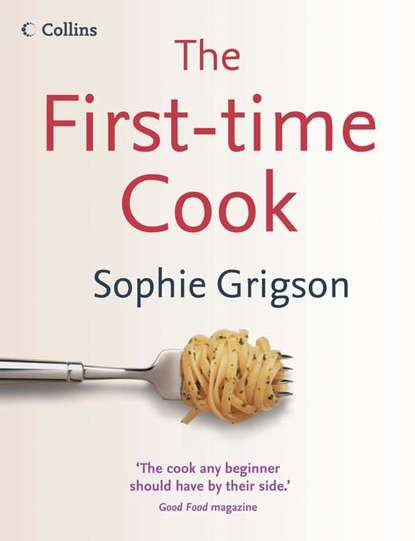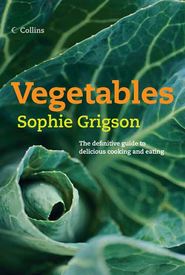По всем вопросам обращайтесь на: info@litportal.ru
(©) 2003-2024.
✖
The First-Time Cook
Настройки чтения
Размер шрифта
Высота строк
Поля
Sautéing is a form of frying. Unlike ordinary frying, which is verging on sedate, sautéing is an energetic business. The word ‘sauter’ is literally the French for ‘to jump’ and that describes the method well. When sautéing the idea is to keep all the pieces of food moving more or less constantly, so that they brown and cook evenly on all sides, and never have a chance to stick on the base of the pan.
Searing and Griddling Searing means cooking food with the minimal amount of fat, on a searingly hot flat surface – probably a heavy-based frying pan. Griddling is similar, but a ridged, heavy griddle pan is used instead.
Simmering means cooking something in simmering water, in other words water that is so hot that a few small bubbles are lazily making their way up to the surface, but not much more than that. The surface of the water will move and tremble gently. In most instances water is first brought up to the boil (i.e. when crowds of bubbles rise ebulliently to the surface), the item that is to be cooked is tipped in, which reduces the temperature of the water below simmering point, and then the whole lot is warmed up again until the water is simmering.
Sweating means cooking over a low heat, with a small amount of fat, the lid clamped on tightly.
Chapter one Soups, Starters and Eggs (#ulink_5e8faf26-109e-5e14-9a87-f2e59a09137e)
Soups
I’m a great believer in soup. Here is a dish that fulfils a multitude of functions, the prime amongst them being that it satisfies the soul. Oh – and the stomach. A big steaming bowlful of soup can really hit the spot. It makes a good first course and it makes the heart of a handsome lunch or supper, eked out with loads of soft-centred, crisp-crusted bread, a big hunk of cheese, and healthy fruit or something more indulgent to follow. Make one big batch and it will feed a crowd, or just feed you on your own quickly and easily over several days.
Types of Soup
Soups divide, fundamentally, into three categories. The first is the puréed soup, with vegetables aplenty boiled up together, then liquidised to silky smoothness (or if you prefer, rustic chunkiness). The second is the bits and bobs, meal-in-a-bowl soup, where a pleasing medley of this and that is simmered in broth, which may or may not be thickened. The third is the incredibly elegant upmarket consommé – a beautiful limpid concoction, intensely flavoured, served in suitably small quantity with maybe a single oyster or whatever floating in its centre. This is restaurant soup, not impossible to make at home by any means, but a good deal of work. If you want a recipe for this type of soup, look elsewhere.
Tips and Techniques
Making soup is all about extracting the maximum flavour from a set of ingredients. Certain techniques, like sweating vegetables and thickening or thinning the soup, are essential to a good result, while others, like stock-making, can be circumnavigated but are worth learning because they have the potential to turn a pedestrian but acceptable soup into a first-rate one. If you want to get the best soup on to your table, read these tips and techniques before you get out the saucepan.
First, a word about the basic structure of a soup. Most soups start off with a group of base ingredients (e.g. onion, garlic, butter or olive oil) that give the soup a background flavour. The main ingredients are what give the soup its predominant flavour – carrots, perhaps, or parsnips, or a medley of vegetables and beans.
Aromatics are the complementary ingredients that scent or spice the soup – usually herbs and spices. The commonest of these is a ‘bouquet garni’ which is a bundle of different herbs, tied together with string so that it can be easily removed before liquidising or serving the soup (see page 20).
All soups need some sort of liquid otherwise they wouldn’t be soups at all! And then last, but not at all least, they need to be seasoned with salt and pepper, or maybe cayenne pepper for a dash of colour and heat combined.
Sweating without Perspiration
Most puréed soups and many meal-in-a-bowl soups start off with a spot of sweating. Not the sort that requires a cold shower, but sweating of the culinary sort. Foodie sweating means cooking vegetables and often herbs with a little fat, over a very low heat, with the lid clamped firmly on the saucepan. Once they are on the stove-top, you barely need to bother with them for a good 10–15 minutes, apart from giving them a quick stir once or twice, but no more. This process develops the full depth of flavour of the vegetables so don’t try to rush it. As long as the heat is low, they’ll produce enough liquid to prevent them sticking or burning.
Thick, Thicker, Thickest
Somewhere among the ingredients will usually be one that serves primarily as a thickener, to give body to the soup. Potatoes are the commonest, but rice, beans or lentils play a similar role. A few more starchy vegetables, e.g. parsnips, need no thickener, as they are quite capable of doing the job themselves.
Liquid Essentials
Obviously soups need some type of liquid to dilute the main ingredients. In certain cases, where there is already a considerable depth of flavour present, water may be quite adequate. Milk can sometimes be used too. The rest of the time you really need a decent stock. This is the backbone of the soup. You can’t taste it specifically, but it is what all the other ingredients rely on for support. An insipid or tasteless stock will produce an indifferent soup. An absolutely tip-top home-made stock will transform the soup into something outstanding.
Stock-cubes and powdered ‘bouillon’ are tolerable stand-bys though not half as good as the real McCoy. Make them up slightly weaker than suggested on the packet so that the factory-brewed overtones are not so evident. You can buy real liquid stocks in supermarkets (sold in small tubs, often stacked alongside the chilled meat) and they come in second best.
By far and away the best option, however, is to make stock yourself. Whenever you have had a roast chicken, say, or find a selection of odds and ends of vegetables hanging around in your veg drawer, knock some stock up, and then freeze it for another day.
Microwave Chicken Stock
This is the ideal list of ingredients, but as long as you have the chicken carcass (most butchers will sell off raw ones cheap, and they do the best job), the onion, the carrot and one or two of the herbs, you can turn out a fine stock. Remember not to add salt to a stock. Why? Just in case you want to boil it down to concentrate the flavour, or add it to other ingredients that are already salty.
1 chicken carcass, raw or cooked
1 onion, peeled and quartered
1 carrot, peeled and quartered
1 leek, quartered
1 celery stalk, quartered
1 bay leaf
2 parsley stalks
1 thyme sprig
8 black peppercorns
1 Break the chicken carcass up roughly. Put all the ingredients into the largest microwaveable bowl you own. Pour over enough boiling water to cover everything.
2 Cover with a tight layer of clingfilm, and then microwave on full power for 25 minutes. Let the whole lot stand for a further 25 minutes, then strain.
Classic Chicken Stock
1 Use the same ingredients on page 15.
2 Pile them into a roomy saucepan, and add enough water to cover generously. Bring up to the boil, then turn the heat down low and simmer very gently – the water should just tremble – for 3 hours, adding more hot water every now and then as the liquid level falls.
3 Once cooked, strain.
Vegetable Stock
The greater the variety of vegetables you add, the better balanced the taste. Avoid potatoes (which make the stock cloudy) and globe artichokes (which make the stock bitter). The sulphurous scent of over-cooked brassicas, such as cabbage, broccoli or Brussels sprouts, is not too pleasant either, so leave them out. This is a good way of using up fresh vegetable trimmings and parings, as long as the vegetables were washed.
1 onion, peeled and roughly chopped
1 carrot, peeled and roughly chopped
1 leek, roughly chopped
2 celery stalks, sliced
2 bay leaves
1 large thyme sprig
3 parsley sprigs
8 black peppercorns
whatever other vegetables you have to hand (e.g. green beans, runner beans, courgettes)







